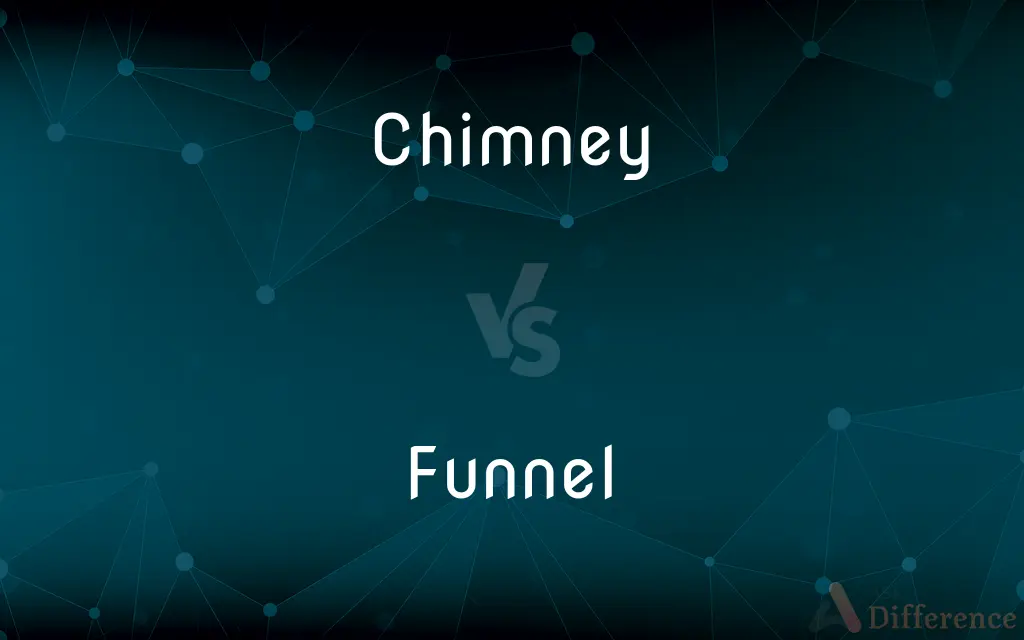Chimney vs. Funnel — What's the Difference?
By Maham Liaqat & Fiza Rafique — Updated on March 19, 2024
A chimney is a vertical structure for venting smoke or gases, while a funnel is a tool for channeling liquids or fine substances.

Difference Between Chimney and Funnel
Table of Contents
ADVERTISEMENT
Key Differences
Chimneys are architectural elements found in buildings, designed to safely direct smoke and combustion gases from fireplaces, stoves, or furnaces to the outdoors. They are typically made of brick, metal, or stone and can be a significant part of a building's structure. On the other hand, funnels are utensils, often cone-shaped with a tube extending from the base, used to guide liquids or fine-grained materials into containers with small openings. They are commonly made from plastic, metal, or glass.
While a chimney's primary function is to provide ventilation and ensure the safe expulsion of harmful gases and smoke from a building, a funnel's role is to aid in the transfer of liquids or powders, preventing spillage and ensuring efficient flow into containers. This fundamental difference in purpose highlights the distinct nature of each tool in its respective domain.
Chimneys can be complex structures, often requiring design considerations such as height, material, and internal lining to function correctly and safely. They must comply with building codes and regulations to ensure they effectively draw smoke upward and prevent backdrafts. Funnels, however, are simple in design and do not require such regulations. Their effectiveness lies in their shape, which uses gravity to direct substances through the narrow end.
In addition to their primary functions, chimneys and funnels can have symbolic or aesthetic roles. Chimneys are prominent features in the skyline of homes and industrial settings, sometimes designed with decorative elements. Funnels, while primarily utilitarian, can also be designed with aesthetic consideration, especially in consumer products or in the context of laboratory glassware.
Despite their differences, both chimneys and funnels rely on the principle of directing flow, whether it's the flow of gases and smoke in the case of chimneys, or the flow of liquids and fine substances with funnels. This common principle underlies their varied applications in different fields.
ADVERTISEMENT
Comparison Chart
Primary Function
Venting smoke/gases from buildings
Channeling liquids or fine substances into containers
Material
Brick, metal, stone
Plastic, metal, glass
Design Complexity
Complex, with considerations for height, material, lining
Simple, functional design
Usage Context
Buildings, for fireplaces, stoves, furnaces
Kitchens, laboratories, industrial applications
Safety and Regulations
Must comply with building codes for safety and efficiency
Generally no specific regulations, focus on spill prevention
Compare with Definitions
Chimney
Chimney for ventilation.
Smoke escaped through the chimney.
Funnel
Funnel in the kitchen.
She used a funnel to pour oil into the bottle.
Chimney
Chimney as a structure.
The house had a tall brick chimney.
Funnel
Funnel's simple design.
The plastic funnel made transferring liquids easy.
Chimney
Chimney maintenance.
Regular chimney cleaning prevents blockages.
Funnel
Funnel for precision.
A funnel helps prevent spills when pouring.
Chimney
Chimney in design.
The chimney was adorned with intricate designs.
Funnel
Funnel in laboratories.
The scientist used a glass funnel for the experiment.
Chimney
Chimney's role in safety.
The chimney ensures safe expulsion of gases.
Funnel
Funnel's utility.
The funnel directed the sand into the narrow jar.
Chimney
A chimney is an architectural ventilation structure made of masonry, clay or metal that isolates hot toxic exhaust gases or smoke produced by a boiler, stove, furnace, incinerator or fireplace from human living areas. Chimneys are typically vertical, or as near as possible to vertical, to ensure that the gases flow smoothly, drawing air into the combustion in what is known as the stack, or chimney effect.
Funnel
A funnel is a tube or pipe that is wide at the top and narrow at the bottom, used for guiding liquid or powder into a small opening. Funnels are usually made of stainless steel, aluminium, glass, or plastic.
Chimney
A passage through which smoke and gases escape from a fire or furnace; a flue.
Funnel
A conical utensil having a small hole or narrow tube at the apex and used to channel the flow of a substance, as into a small-mouthed container.
Chimney
The usually vertical structure containing a chimney.
Funnel
Something resembling this utensil in shape.
Chimney
The part of such a structure that rises above a roof.
Funnel
A shaft, flue, or stack for ventilation or the passage of smoke, especially the smokestack of a ship or locomotive.
Chimney
Chiefly British A smokestack, as of a ship or locomotive.
Funnel
To take the shape of a funnel.
Chimney
A glass tube for enclosing the flame of a lamp.
Funnel
To move through or as if through a funnel
Tourists funneling slowly through customs.
Chimney
Something, such as a narrow cleft in a cliff, resembling a chimney.
Funnel
To cause to take the shape of a funnel.
Chimney
A vertical tube or hollow column used to emit environmentally polluting gaseous and solid matter (including but not limited to by-products of burning carbon- or hydrocarbon-based fuels); a flue.
Funnel
To cause to move through or as if through a funnel.
Chimney
The glass flue surrounding the flame of an oil lamp.
Funnel
A utensil in the shape of an inverted hollow cone terminating in a narrow pipe, for channeling liquids or granular material; typically used when transferring said substances from any container into ones with a significantly smaller opening.
Chimney
(British) The smokestack of a steam locomotive.
Funnel
A passage or avenue for a fluid or flowing substance; specifically, a smoke flue or pipe; the chimney of a steamship or the like.
Chimney
A narrow cleft in a rock face; a narrow vertical cave passage.
Funnel
(transitive) To use a funnel.
Chimney
A vagina.
Funnel
(intransitive) To proceed through a narrow gap or passageway akin to a funnel; to condense or narrow.
Expect delays where the traffic funnels down to one lane.
Chimney
A black eye; a shiner.
Funnel
(transitive) To channel, direct, or focus (emotions, money, resources, etc.).
Our taxes are being funnelled into pointless government initiatives.
Chimney
(climbing) To negotiate a chimney (narrow vertical cave passage) by pushing against the sides with back, feet, hands, etc.
Funnel
(transitive) To consume (beer, etc.) rapidly through a funnel, typically as a stunt at a party.
Chimney
A fireplace or hearth.
Funnel
A vessel of the shape of an inverted hollow cone, terminating below in a pipe, and used for conveying liquids or pourable solids into a vessel with a narrow opening; a tunnel.
Chimney
That part of a building which contains the smoke flues; esp. an upright tube or flue of brick or stone, in most cases extending through or above the roof of the building. Often used instead of chimney shaft.
Hard by a cottage chimney smokes.
Funnel
A passage or avenue for a fluid or flowing substance; specifically, a smoke flue or pipe; the iron chimney of a steamship or the like.
Chimney
A tube usually of glass, placed around a flame, as of a lamp, to create a draft, and promote combustion.
Funnel
A conical shape with a wider and a narrower opening at the two ends
Chimney
A body of ore, usually of elongated form, extending downward in a vein.
Funnel
A conically shaped utensil having a narrow tube at the small end; used to channel the flow of substances into a container with a small mouth
Chimney
A vertical flue that provides a path through which smoke from a fire is carried away through the wall or roof of a building
Funnel
(nautical) smokestack consisting of a shaft for ventilation or the passage of smoke (especially the smokestack of a ship)
Chimney
A glass flue surrounding the wick of an oil lamp
Funnel
Move or pour through a funnel;
Funnel the liquid into the small bottle
Common Curiosities
What is the primary purpose of a chimney?
The primary purpose of a chimney is to vent smoke and gases from a building safely.
How is a funnel typically used?
A funnel is used to channel liquids or fine substances into containers with small openings, preventing spillage.
Is chimney maintenance important?
Yes, regular chimney maintenance is crucial to prevent blockages and ensure safe operation.
Can funnels be used in laboratories?
Yes, funnels are commonly used in laboratories for various experiments and procedures.
Are funnels subject to any specific regulations?
Funnels generally do not have specific regulations, but their design focuses on efficiency and spill prevention.
Are there specific regulations for chimney construction?
Yes, chimney construction must comply with building codes and regulations for safety and efficiency.
Can chimneys have decorative designs?
Yes, chimneys can have decorative designs, especially in residential buildings.
How do funnels prevent spills?
Funnels prevent spills by directing the flow of liquids or fine substances into the desired container.
What are some common uses for funnels outside the kitchen?
Outside the kitchen, funnels are used in laboratories, automotive maintenance, and various industrial applications for precise pouring and transferring of substances.
What materials are chimneys made of?
Chimneys are typically made of brick, metal, or stone.
What safety considerations exist for chimneys?
Chimneys require proper design, construction, and maintenance to prevent fire hazards and ensure effective venting.
Can a funnel be made of glass?
Yes, funnels can be made of glass, especially for laboratory use or culinary applications.
How do funnels aid in precision?
Funnels aid in precision by allowing controlled and accurate pouring of liquids or fine substances.
Can a chimney be part of a building's aesthetic design?
Yes, a chimney can be an integral part of a building's aesthetic, with various designs enhancing its appearance.
How does the design of a funnel contribute to its functionality?
The cone-shaped design of a funnel utilizes gravity to guide substances through the narrow end, enhancing its functionality.
Share Your Discovery

Previous Comparison
Hint vs. Clue
Next Comparison
Completely vs. UtterlyAuthor Spotlight
Written by
Maham LiaqatCo-written by
Fiza RafiqueFiza Rafique is a skilled content writer at AskDifference.com, where she meticulously refines and enhances written pieces. Drawing from her vast editorial expertise, Fiza ensures clarity, accuracy, and precision in every article. Passionate about language, she continually seeks to elevate the quality of content for readers worldwide.













































